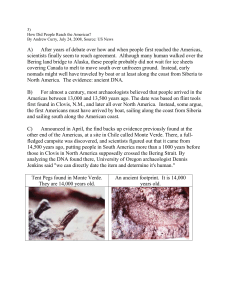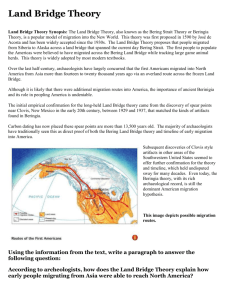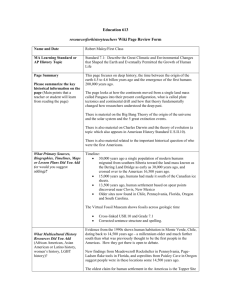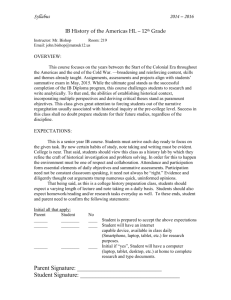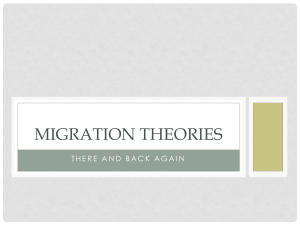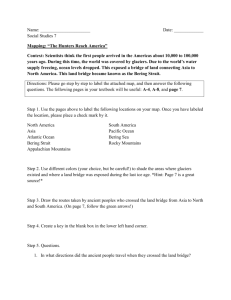How did early people migrate to the Americas?
advertisement
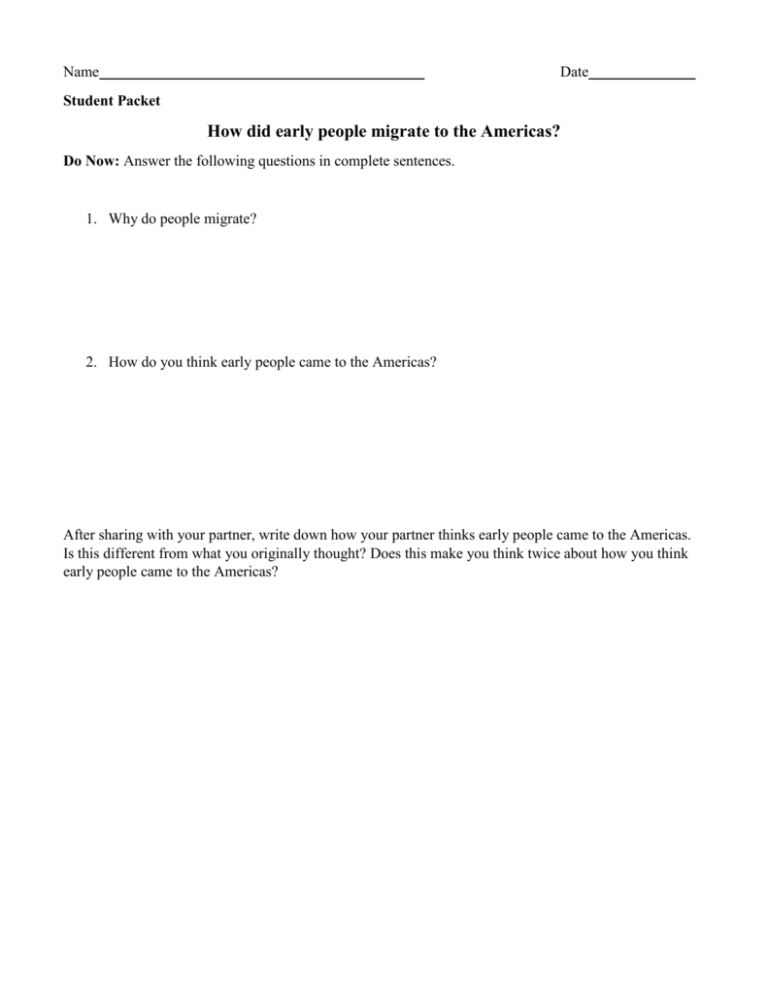
Name Date Student Packet How did early people migrate to the Americas? Do Now: Answer the following questions in complete sentences. 1. Why do people migrate? 2. How do you think early people came to the Americas? After sharing with your partner, write down how your partner thinks early people came to the Americas. Is this different from what you originally thought? Does this make you think twice about how you think early people came to the Americas? Theories of Human Migration LAND BRIDGE THEORY Document 1A It is believed that the first people to arrive in America travelled from Asia (Siberia) to North America (Alaska), and then spread throughout North and South America. At some point during the last Ice Age, about 17,000 years ago, as glaciers advanced and sea levels fell, people were able to cross between the two continents by an exposed land bridge that existed between Siberia and the western coast of Alaska. At this time, ocean levels were 200 feet lower than today which exposed shallow sea floors and enabled people to walk over a land bridge. The first humans (or Native Americans) to enter North America were big game hunters following game such as bison, mammoth, caribou, and horses. This was a natural move that happened over thousands of years as these nomadic people (people that move from place to place) followed the animals in which they hunted. These early Americans soon spread throughout the Americas, diversifying (spreading) into hundreds of culturally distinct nations and tribes that spoke many different languages and lived in very different ways. Native Americas Migration to America Land Bridge Theory (n.d.): n. pag. Dearbornschools.org. Web. 1 July 2014. Document 1B For much of the last century archaeologists believed that Indians came to the Americas through the Bering Strait about thirteen thousand years ago at the tail end of the last Ice Age. Because the sheets of polar ice locked up huge amounts water, sea levels around the world fell about three hundred feet. The shallow Bering Strait became a wide land bridge between Siberia and Alaska. In theory, paleo-Indians, as they are called, simply walked across the fifty-five miles that now separate the continents. Mann, Charles C. "A View From Above." 1491: New Revelations of the Americas before Columbus. New York: Knopf, 2005. 18. COASTAL MIGRATION THEORY Document 2A Archaeologists have supposed (imagined) an ice-free corridor (strip, passageway) east of the Rocky Mountains through which the land bridge people migrated to the western United States, but geologic evidence suggests that corridor may not have existed — at least not until 11,000 years ago. It may be that instead of moving through the interior (inside) of the continent, the first Americans migrated down the west coast of the Americas, which would have been free of ice much earlier than the interior. They may have done so as early as 14,000 years ago, giving them time to reach Chile by 12,500 years ago. Some archaeologists have suggested that these people may even have used boats to skirt the coastline. Human remains have been found in a part of California that was an island, suggesting that someone must have traveled there by sea. This theory suggests a very different way of life for the first Americans — instead of hunting megafauna (large, giant animals), they would have relied on marine mammals for food. "2.2 The Mystery of the First Americans." The Mystery of the First Americans. N.p., n.d. Web. 01 July 2014. Document 2B Evidence for the coastal route is sparse (very limited)…in 2008 and 2009, archaeologists at the University of Oregon reported finding coprolites (fossilized human excrement) and a scraping tool that was older than Clovis (humans from the land bridge theory) in a cave just two hundred miles from the Pacific Coast. And in 2011, Mexican archaeologists scubadiving through an immense water-filled cave network in the Yucatan Peninsula…announced the startling discovery of the mingled skeletons of a human being and a mastodon in a pit at the end of the underwater tunnel four thousand feet long…Still, the coastal route has little empirical (realistic) backing; its supporters tend to endorse the idea mainly because it seems to make sense. In addition, the image of the seagoing people fits into a general rethinking of paleo-Indian life. Mann, Charles C. "Pleistocene Wars." 1491: New Revelations of the Americas before Columbus. New York: Knopf, 2005. 195. Part I: Compare and Contrast Directions: Read documents 1 and 2. As you read, complete the double bubble map below to compare and contrast the two documents. Document 1: Land Bridge Theory Document 2: Coastal Migration Theory Part II: Map Directions: Using the information from documents 1 and 2, draw the two routes of possible human migration. Label North America, South America, Asia, Alaska, Bering Strait, Pacific Ocean, Atlantic Ocean. Use a different color for each route. Make a key. KEY Exit Ticket: Which theory of early human migration do you think is the most probable and why? Give at least two arguments to support your response. Your argument must use text-evidence from documents 1 and/or 2. Complete the graphic organizer below before writing your response. Argument (in your own words) The theory of human migration I chose is… Text Evidence
